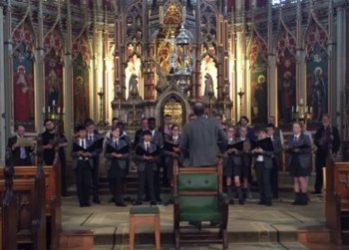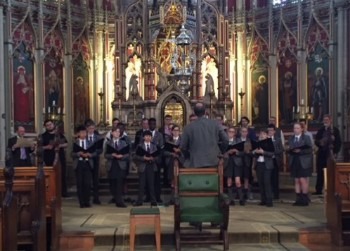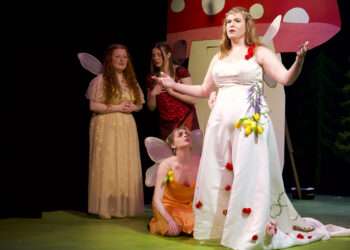
Durham Cathedral and Ushaw College stand just a few miles apart. They are separated physically by the river Wear and for centuries, they were separated spiritually by the great rift caused by the Protestant Reformation. The Benedictine monastery in the cathedral closed, the abbots were replaced by deans, and the building became home to to the established Anglican church. English Catholics meanwhile were ministered to furtively by priests who had trained in France at the English College in Douai. When the English College returned from exile, it established a northern branch at Ushaw, where priests continued to train until a few years ago. This evening the threads of these two great buildings were knitted back together when Durham Cathedral choir gave their first ever concert at Ushaw, with a superbly chosen programme that drew from the traditions and stories of both Cathedral and College.
The choir began in Tudor England, with Latin motets by Parsons and Tallis and Byrd’s Mass for Five Voices – this latter work would have been sung by English Catholics celebrating Mass covertly in their homes perhaps with a priest sent from Douai. The mixed treble line, made up of the top two year groups, made a good, full sound, and the Byrd mass movements were smooth and assured. The Byrd Gloria had a nice swinging pulse, with punchy syncopation, whilst the Sanctus rolled out in waves of sound. The most glorious moment of the mass comes at the end of the Agnus Dei, when the polyphony briefly gives way to passionate chords and the choir provided plenty of force here before returning to the polyphony for a beautifully spacious and peaceful ‘Dona nobis pacem’.
The first half closed firmly in Rome with Allegri’s Miserere Mei. The quartet of soloists floated out ethereally from somewhere at the back of the chapel. Trebles Liliana Banev and Beatrice Smalley alternated on the top line, both of them hitting the famous high-Cs with what sounded like effortless purity. Meanwhile, the full choir were coolly serene, with tenor Phil Durrant providing silky plainsong.
The choir then turned to classics of the English choral repertoire with a trio of Wood, Bairstow and Parry. There was a nice interplay between the two choirs of Wood’s Hail gladdening light, before a big well-sustained ending, although the text was mostly lost in the big acoustic of St Cuthbert’s chapel. Conductor Daniel Cook allowed the acoustic to work to the full in Bairstow’s Let all Mortal Flesh with huge pauses to allow the Alleluias to ring down the building, and the men gave a nice detached lift on ‘King of Kings’. Stanford’s three Latin motets illustrated growing reconciliation between the Anglican and Catholic traditions. Although I would have liked to hear a bit more excitement in Justorum Animae, I really enjoyed the fine legato treble line in Beati quorum via, and the way the Alleluias in Coelos Ascendit bounced off the text
The concert was given as part of a weekend organ course at Ushaw, so cathedral sub-organist Francesca Massey gave participants a flavour of the chapel organ’s versatility with three very varied pieces between the sections of choral music. Francesca’s stylish flourishes and delicate embellishments, played on the reeds and flutes transported us to the sound world of late sixteenth-century Venice in Claudio Merulo’s Toccata Quinto, secondo tuono. Parry’s Germanic Fugue in G was showed off lots of contrasting colours, with a nice dialogue and tension between different parts of the instrument, and an enjoyable flowing solo. Her final piece, Mors et Resurrectio by the French composer Langlais, began deep in the grave with atmospheric deep strings, slowly stirring towards life, and a shining end.
Mors et Resurrectio introduced two European pieces for the final section. Like the Langlais and the Allegri, Duruflé’s Ubi caritas is based on plainsong, and the men’s voices here were sweet and nicely blended. Much of this evening’s programme came from the choir’s regular service repertoire, giving a picture of their daily life in the cathedral: I’ve often heard them sing Rheinberger and his Abendleid tonight was full of the glories of sunset. The concert closed very suitably with a Latin setting of the Nunc Dimittis, written by Holst for another great Catholic building, Westminster Cathedral. As in the Bairstow earlier, there was some fine resonant bass singing here, and a real eventide tranquillity, before the glorious ringing chords to close the concert.






